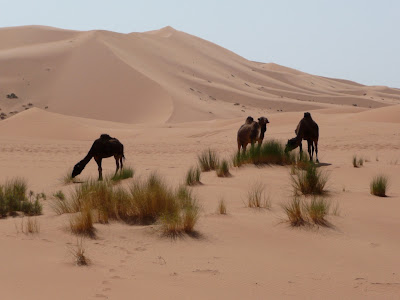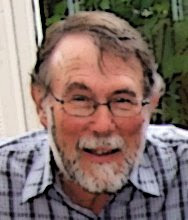There was mud everywhere.
The road across the mountains was amazing: hairpin after hairpin, so that all the time we could look back to see, down below, where we had come from. We reached the pass at 2500m, where we had lunch and then started to descend. But we didn't go down very far, since the desert plains start at well over 1000m asl. As expected it got much drier as we travelled east, but there were surprises: there are several quite large towns and places (oases, I guess) where irrigation, or a natural water supply, allowed plantings of date palms, with the ubiquitous alfalfa and beans in between.
Amazing oasis, unseen in the barren lands until we were right at the edge.
Our first destination was Boumalne de Dades, a Berber town on the edge of the hamada, ie the pebble desert that covers most of the area (sand dunes come later). Our hotel was perched over the town, so that the call to prayer started the waking process at 5.00, since we had a pre-breakfast expedition into the desert to see some of the specialities, such as coursers and sand grouse. As well as the birds, many ground squirrels and fat-tailed desert rats live in the area, and the sand between the pebbles is a records of the previous night's activities.
One of the track-makers.
We call it "desert" but for the locals this is just the landscape in which they live, and as our eyes became accustomed we began to see that there were people all over the place. Most were shepherds, with a flock of sheep and goats, but we also saw people gathering fuel and forage, and a group of nomads who were on their way into town after what was probably a walk of several days from the outer parts of the desert. We met two Berber women on their way back to their camp (in caves in a dry wadi) with big bales of fodder; they were curious but not game to accept an invitation to look down the telescope of a male birder. But when Jean and one of the other ladies met them alone they were very happy to see the binoculars and one of them suggested (jocularly, I guess) that Jean should let her keep them.
Too shy to look down the 'scope.
On another occasion we ran into a very large flock (they disturbed our sand grouse before we got to see them) minded by three heavily veiled women. They came over to see what we were doing and asked us for water, so it was a privilege to transfer the contents of my water bottle into the two litre plastic bottle of one of the women, which was carefully sheathed and carried around her waist. There were no effusive thanks, just a nod of acknowledgment.
The building on the horizon was our hotel!
The Berber people are the original inhabitants here, but they are intermixed with African people from the south and arabs from the north. They speak their own language, but Arabic, and to a lesser extend French, is the universal language. We descended, unannounced on a very small roadside cafe in one town where we simply wanted to eat our picnic, but the owner told us in broken English that "I am Berber, you are welcome, no problem!" and proceeded to go to some trouble to produce tables and chairs. Needless to say we were careful to buy food and drink to make it worth his while, but his welcome was genuine. On another occasion we met a couple of boys who came to see what we were doing, one of whom spoke good English and wanted to practice it. When I asked whether he spoke Berber at home he was a mite scornful, so perhaps there is a little Berber-Arab tension. Certainly the Berbers were a thorn in the side of the French administration well into the mid-twentieth century.
After two nights at Boumalne, we drove to Erfoud, fossil capital of Morocco (but we didn't get to see the good stuff, I'm afraid) and transfered to 4WD vehicles to reach our outermost stop, an auberge at Derkaoua on the edge of the Erg Chebbi dunefield. This place was established by a Frenchman and is a delightful walled complex of mud brick buildings with little courtyards, pools and outdoor dining. We spent two nights there, and in the day in between our 4WDs took us along the edge of the dune field (skirting some settlements which began life as sets for Lawrence of Arabia!) to a remote spot where we met up with a local nomad who was to guide us to see some desert specialities.
Welcome break after an early start.

They're out there somewhere.

Chilly in the early morning.
Not paying attention at the back!
Top of the list was the Houbara Bustard, a bird that has so much significance for some Arabs that it has become severely depleted. The Saudi royal family fly into Morocco to hunt these birds in the traditional way, with falcons. They do at least put quite a lot of money into a breeding program at several sites in Morocco, but it was sad to learn when we did get to see one of the birds that it was the sole survivor of a group that has been whittled down by Saudi hunters.
Another sad thing was to see young boys at the side of the road holding up animals for tourists to photograph. One of these was the "sand fish", a lizard that spends most of its time under the sand dunes, but the worst was a fennec fox, a charming animal that I have always wanted to meet, but not squirming in the arms of a boy, with a collar of blue plastic twine round its neck. We could have bought it and released it, but a) it probably would not survive and b) it does no good at all to encourage these boys (hence no photo).
Having shown us the bustard, and an Egyptian nightjar, in the middle of nowhere, we dropped our nomad off, and he just headed off on foot, who knows where to. Humbling to see that people survive in that environment, where the temperatures were already in the high 30s, in what was still only spring.
But altogether, the desert was an amazing experience and I've barely done it justice.
These looked more natural, but they are all domesticated.


















Wow, this looks amazing and it is great to hear you guys are having fun. Those Fennec Foxes are very cute, the poor thing!
ReplyDeleteIms :)
Amazing stuff, thanks Big A!
ReplyDeleteIncredible... looks so desolate! fab pics :-)
Keep the posts coming!
Ruthie
xx
Amazing journey you are having. The photographs are wonderful. Always so surprising how people can survive in such austere circumstances......
ReplyDeleteThe oasis is incredible!
Lots more please Mr.
Ruth Hobart
Super post Papa,
ReplyDeleteSuch an adventure and a world away from your island home!
I'm going to take the laptop nextdoor so your trip can be vicariously enjoyed a little more.
Thank you for sharing it with us all,
Love you,
Jose
(see I refrained from saying amazing, like the others?)
But it really is . . .
Love the photos! Keep them coming! Great to see you're having such a good time. Love Britt. xo
ReplyDeleteI'm going backwards through your Morocco adventures as I'm out of touch with my online things lately! Great to see more pictures and read tales of seriously dedicated bird watching. Glad there's some good people watching to go with it.
ReplyDelete